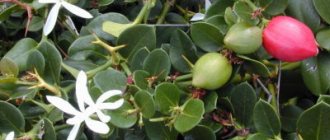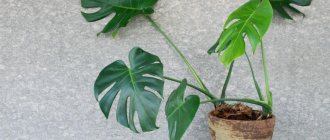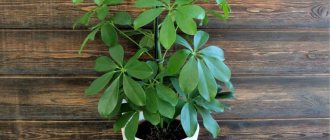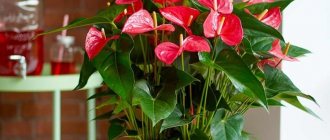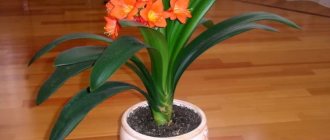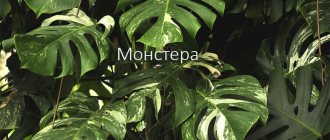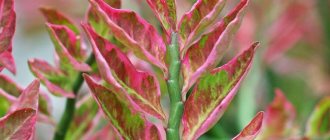Diseases and pests
Due to improper care, monstera is sometimes attacked by pests and diseases. Here are possible problems and their causes:
- Monstera roots rot – soil acidification due to excessive watering.
- Monstera leaves turn yellow - increased air temperature or excess moisture in the soil.
- Monstera grows slowly - lack of light and/or minerals.
- Non-perforated leaves – lack of light and/or nutrients.
- Monstera leaves have brown, dry tips - low air humidity in the room.
- Brown spots on the leaves are a sign of low temperature and/or burns due to direct sunlight.
- Pale monstera leaves - excessive lighting.
- The lower leaves turn yellow and fall off - a natural process of flower growth and maturation.
- The leaf blades become papery and brown - small pot.
- Leaves become deformed due to watering with hard water.
Of the pests, the Monstera can be threatened by spider mites, scale insects and aphids.
Methods for propagating monstera at home
There are several ways in which monstera reproduces - home care includes trimming the shoots for planting material:
- Apical cuttings - cut off the top of the monstera and place it in water, and when the cutting has developed a sufficient number of roots, you can plant it in a pot;
- Stem cuttings - simply place a piece of a monstera stem with at least two buds on the surface of the soil in a pot under film or glass, ventilate the greenhouse from time to time, water and spray the cutting, and when it takes root and leaves appear, transplant it to a permanent place;
- Leaves - if you happen to get a monstera leaf, try putting it in water and waiting for the roots to appear - this method is not very reliable, since the leaf most often dies, but it also has a right to exist;
- Lateral shoots - appear at the base of the monstera stem, they are separated, the cut is sprinkled with charcoal and transplanted into soil made of sand, peat and humus, covered with a bag. The cuttings are watered and ventilated until young shoots appear;
- Stem cuttings with aerial roots - if aerial roots emerge from the side shoot of the monstera, try to develop them; to do this, you can wrap them in damp moss and tie a film on top so that the moisture does not evaporate. You can also tie a cut plastic bottle to the shoot, pour water into it and lower the roots - when they grow, separate the shoot from the main stem with a sharp knife and transplant it into a separate container;
- Seeds - this method is rarely used, but if you have monstera seeds, sow them in a peat and sand substrate, maintain the temperature around +20 °C...+25 °C. When the shoots appear after 2-4 weeks, wait for the first true leaf and plant them in separate containers.
A rare plant looks as exotic as a monstera, caring for which at home can lead to its disease and death only if basic rules are not followed - an acute lack of light, too dry air, waterlogging of the soil in the pot, which causes the roots to rot. But in general, this is a hardy plant that pleases the eye for many years.
Useful properties of monstera
Large monstera leaves actively produce oxygen and increase air humidity, which has a positive effect on the microclimate in the room.
The plant absorbs formaldehyde fumes and electromagnetic radiation, ionizing the air.
There is an opinion that Monstera has a beneficial effect on the nervous system and strengthens the immune system.
What is a variegated monstera
The term "variegata" appears in the names of many plants. Their distinguishing feature is their variegation. This effect was achieved through certain mutations at the gene level. To understand how to properly care for such a plant and how variegated forms differ from others, you need to understand what variegation means.
The presence of white, pink or milky shades in the color of plants is due to the partial presence of chlorophyll-free cells in the genetic composition. They are the result of a mutation. Several genotypes are present in the cell tissues of such plants.
Attention! The nutrition and growth of variegated species is carried out only due to the presence of green parts of the plant. If white color dominates, the flower is not viable.
There are several varieties of monstera with variegated leaves. The most common is Alba - this is the flower that can most often be found in flower shops.
Is it possible to remove aerial roots from Monstera?
If you have monstera, aerial roots or tendrils, this plant makes you wonder what they are for and what to do with them. The presence and good condition of the mustache indicates the health of the monstera and its vitality, but they do not look aesthetically pleasing, and their purpose is not entirely clear. Is it possible to remove aerial roots from Monstera? Read on.
Flower growers do not recommend doing this - you can weaken the plant, which, with the help of these air layering, extracts additional moisture from the air. Many people send them to the same pot in which the vine grows, then as the roots become lignified, the monstera acquires strong natural support, and the airy tendrils extract nutrients from the soil.
monstera aerial roots - pictured
Other gardeners place vases with water or soil next to the monstera and lower the cuttings into them, wrap the airy tendrils in wet moss, in this case their function is breathing and extracting moisture.
You can make a support for the monstera, which will simultaneously feed the aerial roots - take a plastic pipe with a diameter of 10 cm and drill holes into which the aerial layers can freely fit. The surface of the pipe can be wrapped in coconut fiber.
Bury the bottom end of the pipe in the pot and fill the bottom with stones for stability, and fill the rest with moist sphagnum. The mustache will penetrate inside the pipe, and it will serve as both a support and an additional source of moisture for the monstera.
Not all of its owners know how to prune a monstera correctly - this should be done carefully, trying not to damage the aerial roots, and if you need side shoots for propagation, cut them as much as necessary, and if not, just remove the wilted leaves of the monstera. It does not need radical pruning.
Why can't you keep a monstera at home? Myths and reality.
The terrifying name and appearance of the monstera have given rise to many idle rumors and gossip about this plant. You can hear that she is a vampire, sucking energy from her owners, and “steals” oxygen, and that she is terribly poisonous, and so on and so forth. Surprisingly, quite often they believe this, without even bothering to find any more or less reliable confirmation of these rumors and conjectures. Indeed, if you put a monstera in a small room, then at night, when the natural process of photosynthesis is suspended, it absorbs quite a lot of oxygen. But during the day she makes up for this absorption in abundance. This is a normal phenomenon and a completely natural process, which is inherent not only in Monstera, but also in the vast majority of indoor plants. The toxicity of monstera is also exaggerated. It belongs to the aroid family, almost all of which are considered poisonous to varying degrees. But the monstera and dieffenbachia get the most, and even the philodendron, which is considered a monstera twin. But in the descriptions of anthurium, spathiphyllum, calla lilies, aglaonema, zamioculcas and other representatives of this family, this toxicity is mentioned only in passing. But among them there are much more dangerous ones! In Monstera, only the tiny “needles” contained in the leaves can pose a danger, but they also do not pose a particular health hazard, but can only cause irritation (burning) when they come into contact with the mucous membrane.
But the benefits from this plant are much greater than from many plants that are quite safe from a layman’s point of view! Monstera is an excellent natural air humidifier, which is very important for our living spaces with unhealthy, dry air. In addition, it purifies the air from formaldehyde and even absorbs electromagnetic radiation.
Those who like to select indoor plants according to astrological parameters, good omens and other “Feng Shui” will be interested to know that the Monstera zodiac sign is “Virgo”, which means it organizes everything around it, including thoughts and actions. In Southeast Asia, monstera is considered a plant that brings happiness, good luck, and health. There it is often planted at the entrance to the house, considered the keeper of the hearth, and if a family member gets sick, then a pot of monstera is placed near him.
Summarizing everything written above, we can say that Monstera is a completely safe plant. And when deciding to have one in your house, you should be guided not by doubts and recommendations on the topic “why you can’t keep a monstera in your house,” but only by common sense. First of all, assess the area of the room where you are going to grow it. To grow a monstera at home, it can be up to 3 meters in height, not to mention the “scattering” of leaves in width. Therefore, be prepared to share your living space with her. Do not place it in the bedroom or nursery, especially if they are small and there is no flow of fresh air, because after all, it absorbs oxygen at night. Now let’s learn more about its cultivation.
How to speed up the growth of monstera?
To stimulate the growth of new leaves, it is recommended to cut off the top and shape the development as you wish. Monstera is often damaged by spider mites and scale insects. To combat these insects, you can use a soap solution or any approved insecticide.
Interesting materials:
How long does homemade sausage last in the freezer? How long do homemade cosmetics last? How long does homemade hydrosol last? How long does Jägermeister last? How long does ethyl alcohol last? How long does a French baguette last? How long can cooked trout be stored? How long does cooked beef last in the refrigerator? How long can cooked chicken liver last? How long does finished meringue last?
